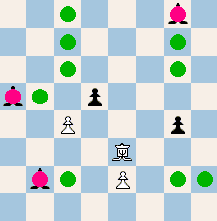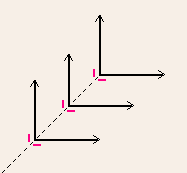

The Retiar is a bifurcation piece. It always moves in two legs; the first is a diagonal slide, and the second is an orthogonal bounce-move, along either of two orthogonals in the prolonged movement-direction. If the Retiar cannot bounce, then it cannot move. The Retiar also bounces against the side of the board, but this is only geometrically possible when it moves from one of the extra corner squares, and bounces along the knight file. The Retiar's value is 3, that is, the same as a bishop or knight (preliminary estimate). Other rules are the same as in standard chess, except for the possible promotion to Retiar.
The H-shaped board gives the Retiar good strategical possibilities. The initial setup divests the Retiar of immediate attacking possibilities, thus avoiding strategical monotony. Although the Retiar is dependent on screens for moving it is a very dynamic and difficult piece that puts great demands on the chessplayer. The extra corner squares (the trenches) are exactly what the majesty has always asked for. The notorious problem of the weak first rank, and the sudden rook mate, is thereby solved. The trenches affect the strategy greatly. While the Retiar can easily create threats on the first rank, these squares are often useful to the king. Retiar Chess, and the new Retiar piece, were invented by undersigned, September 2006.
The Retiar (lat. retiarius), the "net man", was one of the best-known gladiator types in ancient Rome. The Retiar was armed with net and trident. He lacked helmet and shield, but instead wore a big shoulder guard.
 The Retiar always moves in two legs, the first is a diagonal slide and the second is an orthogonal bounce-slide (red = capture).
The Retiar always moves in two legs, the first is a diagonal slide and the second is an orthogonal bounce-slide (red = capture).
 The Retiar's movement principle. In any of its four diagonal movement directions, there could be many screens to choose from. The screens, that are used for bouncing, occur anywhere on the first leg.
The Retiar's movement principle. In any of its four diagonal movement directions, there could be many screens to choose from. The screens, that are used for bouncing, occur anywhere on the first leg.
• You can download my free Retiar Chess program here, but you must own the software Zillions of Games to be able to run it (I recommend the download version).
• Don't miss my other chess variants.
© M. Winther (September 2006).